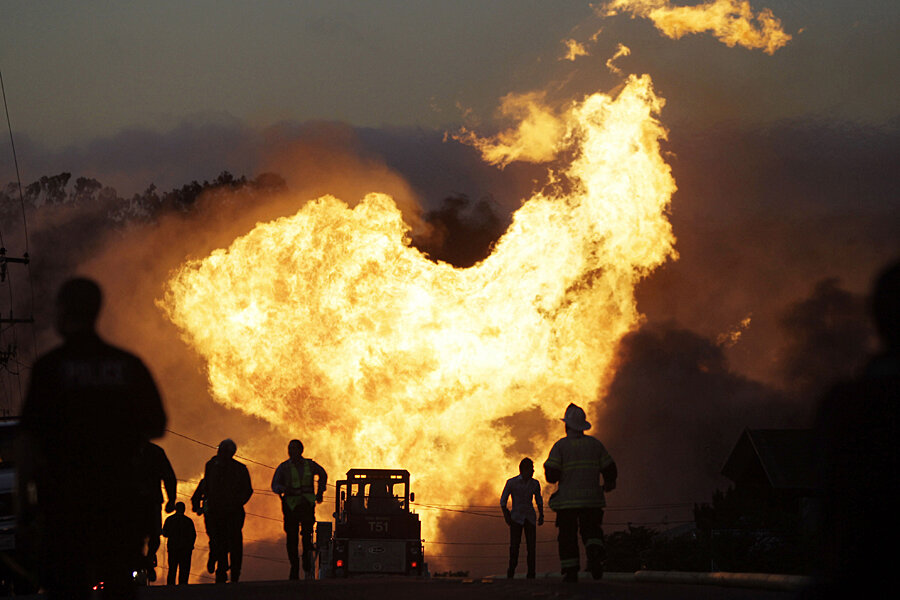PG&E gets $1.4 billion fine for gas pipeline explosion
Loading...
| SAN FRANCISCO
California regulatory judges issued a $1.4 billion penalty on Tuesday against the state's largest utility for a 2010 gas pipeline explosion that engulfed a suburban San Francisco neighborhood in fire, killing eight people and prompting national alerts about aging pipelines.
The California Public Utilities Commission (CPUC) said the figure reached by two administrative law judges against Pacific Gas & Electric Co. would be the largest safety related penalty it had ever imposed. PG&E can appeal the fine.
The next largest CPUC safety related penalty imposed in the recent past was a $38 million penalty against PG&E as a result of a natural gas explosion on December 24, 2008, in Rancho Cordova, Calif., CPUC said in a statement Tuesday.
An email to a company representative for comment was not immediately returned. But PG&E said in a statement it fully accepts that a penalty is appropriate.
"We have respectfully asked that the commission ensure that the penalty is reasonable and proportionate and takes into consideration the company's investments and actions to promote safety," PG&E said.
The commission previously ordered PG&E to pay $635 million for pipeline modernization in the wake of the Sept. 9, 2010, blast in the suburban San Francisco community of San Bruno. It destroyed more than three dozen homes and was California's deadliest utility disaster in decades.
The $1.4 billion penalty includes a $950 million fine that PG&E must pay into the state's general fund, $400 million for pipeline improvements, and about $50 million to enhance pipeline safety. PG&E cannot recover any of the money from customers, including the earlier $635 million penalty.
The administrative law judges found that PG&E committed nearly 3,800 violations of state and federal laws, rules, standards or regulations in the operation of its gas transmission system. In their decision, the judges addressed the severity of the accident:
In light of the gravity and severity of the offenses, PG&E’s statutory obligation to provide safe and reliable gas service, PG&E’s own acknowledgement that it had failed to comply with federal and state regulations and PG&E’s own procedures in multiple instances, the resulting deaths, other injuries and property damage, PG&E’s violation of Rule 1.1 of the Commission’s Rules of Practice and Procedure, and the Commission’s and the public’s interest in ensuring safe and reliable natural gas service, a significant penalty is warranted.
The blast occurred when a 30-inch natural-gas transmission line installed in 1956 ruptured. At the time, survivors described the heat of the blast burning the back of their necks like a blowtorch as they ran away.
San Bruno city officials were just beginning to study Tuesday's decision, but it appeared the penalty fell short of what was needed to ensure PG&E upgraded pipeline safety as much as necessary, city manager Connie Jackson said.
"Based on what we're seeing, it does not appear that this penalty amount goes far enough," Jackson said.
A 2011 investigation by the National Transportation Safety Board concluded that the rupture occurred in a weak weld in a pipeline that PG&E records had shown as being smooth and unwelded. PG&E neglected to shut off natural gas feeding the fire until 95 minutes after the blast, the federal investigators said.
The 2011 probe found PG&E's safety management of its pipelines overall deficient and ineffective. At the same time, the federal board also faulted what it called the ineffectiveness of California's Public Utilities Commission in regulating the power utility, whose service area covers all but the southern one-third of California.
This year, federal prosecutors separately indicted PG&E on 27 counts alleging the utility violated pipeline safety requirements. Another federal count alleges PG&E lied to the National Transportation Safety Board in that agency's investigation of the San Bruno blast.
PG&E faces additional fines of more than $1 billion if convicted of the federal charges, which are separate from the financial penalties that the California state administrative judges weighed.
PG&E pleaded not guilty to the federal counts earlier in August.
___
AP writer Garance Burke contributed to this report.







